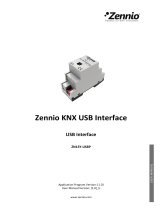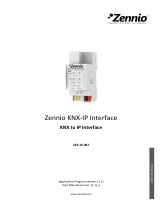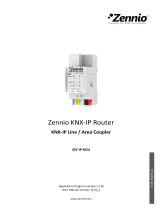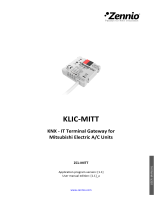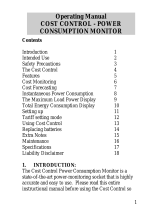Page is loading ...

KES 1xThree-Phase
(KNX Energy Saver)
Three-Phase System
Energy Saver
ZN1IO-KES
USER MANUAL
Application Program Version: [2.1]
User Manual Version: [2.1]_a
www.zennio.com

KES 3xSingle-Phase
http://www.zennio.com Technical Support: http://zennioenglish.zendesk.com
2
Contents
Document updates ................................................................................................................... 3
1 Introduction ......................................................................................................................... 4
1.1 KES, the Energy Saver ................................................................................................... 4
1.2 Instalation .................................................................................................................... 5
1.2.1 Measuring Probe ................................................................................................... 7
2 Configuration ....................................................................................................................... 9
2.1 Active Power ................................................................................................................ 9
2.2 Active Energy .............................................................................................................. 10
2.3 Power Limits ............................................................................................................... 11
3 ETS Parametrisation ........................................................................................................... 12
3.1 Default Configuration ................................................................................................. 12
3.2 General Window ......................................................................................................... 14
3.2.1 Active Energy ...................................................................................................... 18
3.2.2 Active Power ....................................................................................................... 22
3.2.3 Power Limit Monitoring....................................................................................... 24
3.3 Logical Functions ........................................................................................................ 28
ANNEX I: Time Management ................................................................................................... 29
ANNEX II: Further Examples .................................................................................................... 33
ANNEX III: Comunication Objects ............................................................................................ 47

KES 3xSingle-Phase
http://www.zennio.com Technical Support: http://zennioenglish.zendesk.com
3
DOCUMENT UPDATES
Version Changes Pages(s)
[2.1]_a
Changes in the application program:
• Higher precision in the measurement of the cost if tariff
switches occur during the measuring period.
• Improvement in the module of the Logical Functions to
avoid sending unexpected values.
-
Update of the Object Table. 47 - 48
Revision of styles and minor clarification of certain texts. -
[2.0]_a
Changes in the application program:
• New algorithm for calculating energy consumptions.
• Minor changes in texts.
-

KES 3xSingle-Phase
http://www.zennio.com Technical Support: http://zennioenglish.zendesk.com
4
1 INTRODUCTION
1.1 KES, THE ENERGY SAVER
The KNX Energy Saver from Zennio, KES, combines in only one device the following
features:
Support for single-phase and three-phase environments (two independent
application programs):
KES 1x-ThreePhase, destined to three-phase electric systems, where
each of the measuring probes will monitor one of the phase lines.
KES 3x-SinglePhase, destined to single-phase electric systems, where
each measuring probe can be used to monitor three independent
electric conductions (channels).
3 independent input channels for the connection of up to three measuring
probes (model ZN1AC-CST60) to monitor three independent single-phase
lines or one three-phase line (depending on the application program), which
permits the following functions:
Measuring and reporting the instant active power consumptions
(kW).
Calculating and reporting the active energy consumptions (kWh).
Calculating and reporting the cost of the energy consumption (with the
possibility of setting up 4 different tariffs) as well as the volume of the
CO
2
emissions required to generate such energy.
Monitoring power limits.
Hourly, daily, weekly and monthly report of total energy consumption, as
well as upon request (through a global request object).
Sending of the actual and average values of the consumed energy, the cost
incurred and the corresponding CO
2
emissions (every day, every week, every

KES 3xSingle-Phase
http://www.zennio.com Technical Support: http://zennioenglish.zendesk.com
5
month or upon request).
Synchronisation through an external KNX clock.
Module with up to 5 multi-operation logical functions.
Note: the measurement algorithm implemented in versions 2.0 and later of KES can
correctly compute power consumptions in a variety of alternating currents, including
non-sine signals and signals generated by dimmers. This makes KES able to work with
signals of any shape and to measure power consumptions with all kinds of appliances
and devices in the home and industrial environments.
Figure 1 The KES Energy Saver.
1.2 INSTALATION
KES connects to the KNX bus via the bus connecting terminals.
The input channels are connected to KES through the screw terminal included in the
device packaging.
Once KES is provided with power from the KNX bus, both the individual address and
the associated application program can be downloaded.
Figure 2 shows the element scheme of KES.

KES 3xSingle-Phase
http://www.zennio.com Technical Support: http://zennioenglish.zendesk.com
6
1.- KNX Terminal
2.- Programming LED
3.- Programming Button
4.- Input Slot
Figure 2 Element scheme.
The functionality of the main elements is described below:
Programming Button (3): a short press on this button sets the device into
the programming mode, making the associated LED (2) light in red. If this
button is held while plugging the device into the KNX bus, KES will enter the
Safe Mode. The LED will then blink in red.
Input Terminal (4): slot for the insertion of the screw input terminal (see
figure below) and therefore for the connection of the different measuring
probes provided with the device. A different probe will be required per
electrical line being monitored. The two wires of each measuring probe will be
inserted into the two connection points of the particular input channel to be
used. For instance, if three electrical lines are going to be monitored, one
probe will need to be connected to the slots 1 and 2 (referred to as “Channel
A” in the Single-Phase application program), another one to the slots 3 and 4
(“Channel B”), and a third one to the slots 5 and 6 (“Channel C”). In the case
of the Three-Phase version, each probe will be destined to monitor one of the
three phase lines in the electrical system.
Note: the insertion order of the two terminal wires from the measuring probe to the
connection slots does not affect the functionality. I.e., for the first input channel it is
possible to connect either one of the wires from the probe into point 1 and the other
cable into point 2, or either the inverse.
Figure 3 screw input terminal.

KES 3xSingle-Phase
http://www.zennio.com Technical Support: http://zennioenglish.zendesk.com
7
1.2.1 MEASURING PROBE
The set-up process of the ZN1AC-CST60 measuring probe (Figure 4) is described
next.
Figure 4 Zennio ZN1AC-CST60 Measuring Probe.
The required steps are:
Open the top clamp of the probe.
Pass the phase wire from which the energy measures will be taken
through the gap that has just been uncovered in the probe.
Important: only one phase line should be inserted into the measuring
probe, not the entire power cable with the neutral and other phases.
Close back the top clamp of the probe.
Connect the two wires of the measuring probe into the two connection
slots of the KES terminal block that correspond to the desired channel.
Please remember that KES only performs measurements of the power consumed by
alternating current (AC) lines.
Note: it is very important to keep in mind that neither ordinary power supplies (230 V)
nor other external supplies should be connected to the KNX bus, nor directly to the
input terminal of KES.
For detailed information about the technical features of KES, as well as on security and
installation procedures, please refer to the device Datasheet, bundled within the device
packaging and also available at http://www.zennio.com.

KES 3xSingle-Phase
http://www.zennio.com Technical Support: http://zennioenglish.zendesk.com
8
Hereafter, this user manual will only refer to the KES 1xThree-Phase application
program, intended for three-phase systems. The specific user manual for the KES
3xSingle-Phase application program, intended for single-phase systems, can be
downloaded from the http: //www.zennio.com website.

KES 3xSingle-Phase
http://www.zennio.com Technical Support: http://zennioenglish.zendesk.com
9
2 CONFIGURATION
2.1 ACTIVE POWER
KES 1xThree-Phase calculates the value of the active power consumed by a three-
phase system whose phase lines are passed through the three ZN1AC-CST60 probes,
which are connected themselves to the input channels of KES. This active power is
obtained from the effective intensities measured by the probes and according to the
following relation, which, in general, can be applied to three-phase systems:
𝑃
𝑎𝑐𝑡
=
𝑉
𝑒𝑓
√
3
𝐼
𝑒𝑓
· 𝐹𝑃 =
𝑉
𝑒𝑓
√
3
(𝐼
𝑒𝑓 𝐴
+ 𝐼
𝑒𝑓 𝐵
+ 𝐼
𝑒𝑓 𝐶
) · 𝐹𝑃
where 𝑉
𝑒𝑓
is the effective voltage of three-phase installation and 𝐹𝑃 is the power factor.
Both values must be defined by parameter. The values of the effective intensities, 𝐼
𝑒𝑓
,
are obtained, as stated above, by placing the measuring probes around the phase
cables, and plugging the outputs of the probes into the input channels of KES.
KES assumes an ideal situation with a sole and constant power factor (defined by
parameter) for the whole three-phase installation. Moreover, the three-phase
installation itself is supposed by KES to be either:
Balanced, or
Unbalanced and star-connected, with its central point referenced to the
neutral wire,
which therefore makes KES 1xThree-Phase particularly suitable for these types of
systems or situations.

KES 3xSingle-Phase
http://www.zennio.com Technical Support: http://zennioenglish.zendesk.com
10
Figure 5 Measuring the active power consumed by a three-phase system
Regarding the effective intensities, the values than can be measured by the probes
are [300 mA – 60 A], which in a 380v three-phase balanced installation with a power
factor of 100% would approximately correspond to [342 W – 68,4 kW].
Once beyond the aforementioned 300 mA, the resolution in the measurement of the
instant power is determined by the DPT of the 2-byte floating-point object used to
transmit the value to the bus (0.01 kW).
In addition to measuring instant active power, KES can also monitor the highest power
detected, so that power peaks can be calculated per hour, day, week and month,
which may be interesting for managing historic values.
2.2 ACTIVE ENERGY
Based on successive values of the instant power, KES can perform the count of the
total energy consumed per hour, day, week or month, as well as calculating daily,
weekly and monthly average consumptions.
KES can also make estimations of the energy that would be consumed during a
whole day if the current value of the instant power were constant for the 24 hours. This
estimation can be expressed in terms of consumption (kWh) and in terms of cost (local
currency).

KES 3xSingle-Phase
http://www.zennio.com Technical Support: http://zennioenglish.zendesk.com
11
Daily, weekly and monthly values of the actual energy consumed can be expressed in
terms of consumption (kWh), of cost (local currency), or even in terms of the CO
2
(kgCO
2
) sent to the atmosphere for the production of such quantity of energy.
If both estimations and energy consumptions are set to be expressed in terms of cost,
KES allows specifying up to four different tariff values (in cents of the local currency per
kWh).
2.3 POWER LIMITS
KES can also monitor the level of the power consumption in relation to certain limits,
initially defined by parameter: an upper limit and a lower limit (linked to an
overconsumption alarm and to a low-consumption indicator, respectively), and to a
certain margin (hysteresis or deadband) regarding each of the two limits.
Figure 6 shows an example of the process. W hen the instant power is higher than the
upper limit, KES sends an overconsumption alarm (if configured) and this will not be
deactivated until the instant power is back again under the upper limit minus the margin
band. If the value of the instant power keeps decreasing, KES will send (if configured)
a low-consumption indicator as soon as the power is lower than the lower limit. This
indicator will remain active until the power is back again higher than the lower limit plus
the margin band.
Figure 6 Power Limit Monitoring.
These concepts will be explained in detail in section 3.2.3 of this user manual.
Upper Limit
Lowerlimit
Deadband
Deadband
Overconsumption
Alarm ON
Overconsumption
Alarm OFF
Low
Consumption
Alarm ON
Low
Consumption
Alarm OFF

KES 3xSingle-Phase
http://www.zennio.com Technical Support: http://zennioenglish.zendesk.com
12
3 ETS PARAMETRISATION
For beginning with the parameterisation of KES it is necessary, once the ETS program
has been opened, to import the product database (KES 1xThree-Phase application
program).
Next, the device must be added to the project where desired. Right-clicking on the
name of the device will display the “Edit parameters” option, which allows the
parameterisation itself.
The following sections describe in detail the different options available in ETS.
3.1 DEFAULT CONFIGURATION
When no particular parameterisation has been defined yet, the device and its objects
will show as in Figure 7.
Figure 7 Default Topology.
Objects “Time” and “Date” are shown first in the list. Their purpose is to set the time
and date of KES by means of an external KNX clock. Their functionality and everything
related to the time management will be detailed in ANNEX I: Time Management.
“Global Reset” and “Global Request” are listed next. When the value “1” is received
by the earlier, every counter and every calculation will be reset to their default values,
so every object related to instant values, estimations, total values and average values
that had been enabled by parameter will become zero, as well as every variable
needed for calculations. In addition, communication objects related to tariffs and the
upper and lower limits will return to their original values, that is, the one parameterised

KES 3xSingle-Phase
http://www.zennio.com Technical Support: http://zennioenglish.zendesk.com
13
through the corresponding ETS fields. After that the measuring and calculating process
will start over. The value “0” written to this object will have no effect.
Regarding “Global Request”, the value “1” through this object will cause an extra
sending of all the communication objects related to the power consumption which,
because of having been parameterised in such way, are already being sent to the bus
at certain times: instant values, accumulate values, average values, peak values, etc.
In other words, a global request forces the re-sending of everything that KES, with no
need of a specific external request, already sends periodically to the bus. Objects not
related to a periodical sending will consequently not be sent, such as “Total Energy”,
“Total Cost”, etc. In addition, when the global request takes place, objects for which a
periodical sending is available but have not been parameterised in ETS will not be sent
either.
The behaviour of the communication objects “Tariff x” and “Switch to Tariff x”, shown
by default, will be detailed later.

KES 3xSingle-Phase
http://www.zennio.com Technical Support: http://zennioenglish.zendesk.com
14
3.2 GENERAL WINDOW
The general screen, shown in Figure 8, permits setting generic parameters related to
the operation of the Energy Saver.
Figure 8 Default Configuration Screen.
AC Power Supply Voltage [V]: this field is to configure the effective three-
phase voltage of the electric network (0-450v). The default value is 380.
Power Factor [%]: this parameter defines, as a certain percentage, how the
active power (the one actually consumed by the load) and the total power
supplied are related (see section 2.1). The default value is 100%.
Carbon Dioxide Ratio: amount of CO
2
(in cents of a Kg) sent to the
atmosphere to produce one unit of energy (kW h).
Note: the value shown by default (0.5 kg CO
2
/kWh) is approximately similar
to the regular ratios in Europe. It is always possible to change it by entering
values more accurate for the system being monitored or by directly setting the
exact value that can usually be found on the electric bill provided by the
power supplier.

KES 3xSingle-Phase
http://www.zennio.com Technical Support: http://zennioenglish.zendesk.com
15
Tariffs. Tariff “x”. Initial Value: Initial value for tariff “x” (out of up to four
different tariffs) for the calculation of the cost (estimated, actual or average) of
the energy consumptions. This value should be expressed in cents of the
local currency.
KES permits defining up to four tariffs with different electric fees, and to
switch from one to another in runtime (the active tariff by default is tariff 1). To
make this possible, there are four 1-bit objects (“Switch to Tariff x”) that
allow, by sending the value “1”, changing from one tariff to another. These
objects may be linked to an external timer so that, for example, depending on
the time band in which KES takes consumption samples, one tariff or another
is used, making cost estimations more precise.
It is also possible to change in runtime the value itself of each tariff. Four 2-
byte objects (“Tariff x”) can be found for this purpose, making it possible to
update the value originally defined by parameter.
Should any of the tariffs be unnecessary, the “Switch to tariff x” object can be
left unlinked.
Date and Time Request on Bus Voltage Recovery: defines how much time
(1 to 255 seconds) KES should wait, whenever the bus voltage is recovered
from a bus failure, before sending the time and date requests through the
KNX bus. See ANNEX I: Time Management.
Cyclical Sendings: these parameters are destined to enable/disable
periodically sending certain objects related to the measurements. This
includes both, a Security Sending (in other words, re-sending values that
had already been calculated and reported to the bus but that can be sent
again periodically) and the Continuous Sending of certain updated values.
In order to better understand how KES counts these periods and the exact
instant when the objects are sent, please refer to ANNEX I: Time
Management.
Security Sending of Last Daily Values: allows periodically re-sending
the values related to the previous day, being possible to select cycle
times of 1, 2, 3, 4, 6 or 12 hours (“0” disables this sending). This way, all
the daily values enabled under “Active energy” (see section 3.2.1) will

KES 3xSingle-Phase
http://www.zennio.com Technical Support: http://zennioenglish.zendesk.com
16
not only be sent at the end of the day, but also during the following day,
every time the selected period expires.
Security Sending of Last Weekly Values: permits periodically re-
sending the values related to the previous week, being possible to select
cycle times of 1 to 7 days. (“0” disables this sending). This way, all the
weekly values enabled under “Active Energy” (see section 3.2.1) will not
only be sent at the end of the week, but also during the following week,
every time the selected period expires.
Security Sending of Last Monthly Values: permits enabling the
periodic re-sending of the values related to the previous month, being
possible to select cycle times of 1 to 30 days (“0” disables this sending).
This way, all the monthly values enabled under “Active Energy” (see
section 3.2.1) will not only be sent at the end of the month, but also
during the following month, every time the selected period expires.
Sending of Daily, Weekly and Monthly Peak Power Values: allows
periodically sending the instant (updated) values of the daily, weekly and
monthly peak power, being possible to select a cycle time of 1, 2, 3, 4, 6
or 12 hours (“0” disables this sending). This way, the peak power values
enabled under the “Active Power” screen (see section 3.2.1) will not only
be sent when corresponding to each (at the end of the day, at the end of
week, or at the end of the month), but also every time the selected
period expires, letting the bus know how the peak values change during
the current day, week and month.
Reset after Request?: when this parameter is enabled (“Yes”), the value of
the communication objects and variables related to the total consumptions
will be reset to zero every time KES responds to a request of the total
consumption values since the last reset. This request is performed by
sending the value “1” through the “Request” object.
Logical Functions: after enabling this parameter, the menu on the left will
include a new tab for the configuration of the logical functions. See section
3.3 for further information.
Measuring Options: this parameter permits enabling different measuring
alternatives: active energy, active power and power limit monitoring. These

KES 3xSingle-Phase
http://www.zennio.com Technical Support: http://zennioenglish.zendesk.com
17
options and their respective parameterisation will be explained in later
sections.
Three more 1-bit communication objects will be initially shown, independently of which
of the measuring options have been enabled: “Partial Reset”, “Request” and “Disable”
(not to be confused with the previously mentioned “Global Reset” and “Global Request”
parameters).
When the Energy Saver receives the value “1” through the “Partial Reset”
object, every communication object and variables related to estimates and
average / total values will be re-set to zero. Receiving the value “0” will have
no effect.
When the Energy Saver receives the value “1” through the “Request” object,
it will report the accumulate values –since the last reset– for the energy
consumption, the incurred cost and the carbon dioxide emissions. These
values are reported through the “Total Energy”, “Total Cost” and “Total CO2
Emissions” communication objects, respectively, which will automatically
show up when the corresponding option gets enabled in ETS. In addition, if
“Reset after request” has been enabled under the General screen, whenever
a “1” is received through the “Request” object, a reset process similar to the
one described above will also take place.
Note: the three Total objects are not intended to be read independently; their
values will only be updated and sent to the bus all together, as a response to
the “Request” object.
The “Disable” object allows enabling or disabling power measures (according
to the KNX standard, “0” corresponds to disabling the measurement and “1”
corresponds to enabling it). When this measurement has been disabled, the
cyclical sending of the instant power is interrupted (in case it had been
previously parameterised), and the consumption is considered zero from that
moment. Note that deactivating this measurement is not equivalent to simply
not powering the device (which would make it not aware of time passing), but
to measuring a null power consumption although time is still passing.
However, in order to clarify this point, reading ANNEX II: Further Examples is
encouraged (specially, Example II).

KES 3xSingle-Phase
http://www.zennio.com Technical Support: http://zennioenglish.zendesk.com
18
On the other hand, when the power measuring process is disabled, some
more sending is interrupted, according to the table shown below:
“Disable” = 0 “Disable” = 1
Cyclic sending of instant power
Sending of peak power
Cyclic re-sending of peak power
Sending of effective consumptions
Cyclic re-sending of effective consumptions
Cyclic sending of estimated consumptions
Sending of average consumptions
Time passed counts for average values?
(
1
)
Real consumption counts for calculations?
Table 1 Sending vs. Activation/Deactivation of Power Measures
All the parameters from the Active Energy, Active Power and Power Limit Monitoring
screens as well as their configurable values will be detailed in the next pages.
3.2.1 ACTIVE ENERGY
This screen allows the configuration of several parameters related to the consumption
of active energy (section 2.2). These are shown grouped into sections, as explained
below.
Estimated Values. Permits the configuration of parameters related to the
estimation of the active energy consumption, expressed in kWh, as well as
the estimated cost, in terms of the local currency. This estimation of the
active energy consumed is made by assuming that the instant power
consumption at the moment of the estimation remains constant during the
24 hours of the current day.
1
See Example II of ANNEX II: Further examples.

KES 3xSingle-Phase
http://www.zennio.com Technical Support: http://zennioenglish.zendesk.com
19
Figure 9 Active Energy. Estimations.
Related to estimations, two communication objects come up: “Estimated
Energy Consumption” and “Estimated Cost”, being possible to configure the
following:
Minimum Time Between Sendings: allows setting the minimum time,
in seconds, that should pass between the sending of every two
consecutive values of the corresponding object (“Estimated Energy
Consumption” and/or “Estimated Cost”), no matter if they correspond to
a cyclic sending or to a sending due to a change of the value. Valid
times are [5-255] seconds. This minimum time between the two will only
be taken into account if a value other than “0” is parameterised for the
fields “Cycle Time” or “Send on Value Change”.
Cycle Time: allows setting the period for sending the objects “Estimated
Energy Consumption” and/or “Estimated Cost”, in seconds. In other
words, every how much time these values will be sent to the KNX bus.
Note: if the value specified here (x) is lower than the minimum time
between sendings (y), the latter will prevail, resulting in a sending taking
place only every “y” seconds. If “0” is parameterised for “Cycle Time”, no
periodic sending of the associated communication object will take place.
Send on Value Change: allows setting a certain value so that whenever
a change in the estimated consumption (either in kWh or in units of the
local currency) greater than this value is detected, a new sending of the
corresponding communication object (“Estimated Energy Consumption”

KES 3xSingle-Phase
http://www.zennio.com Technical Support: http://zennioenglish.zendesk.com
20
or “Estimated Cost”) will happen. If there is no need of this feature, this
field can be left with value “0”.
Note: if a value other than “0” is set for the fields “Cycle time” and “Send
on Value Change”, the associated objects (“Estimated Energy
Consumption” and “Estimated Cost”) will also be sent to the KNX bus
whenever the value “1” is received through the “Global Request”
communication object.
Hourly Values. From this section it is possible to enable the sending of the
communication objects related to the energy consumption during the last
hour, either in kWh (object “Last Hour Energy Consumption”) or as the
associated cost (object “Last Hour Cost”). These objects will be shown
once their own parameters have been enabled.
Daily Values. From this section it is possible to enable the sending of the
communication objects related to the energy consumption (kWh) during the
last day, the related cost (local currency) and the related CO
2
emissions
(kgCO
2
). These objects are: “Daily Energy Consumption”, “Daily Cost” and
“Daily CO2 Emissions”. It is also possible to enable the sending of the daily
average values: “Average Daily Energy Consumption”, “Average Daily
Cost” and “Average Daily CO
2
Emissions”.
Note: objects referring to average daily values (energy consumption, cost
or CO
2
emissions) represent the total consumption (in kWh, local currency
or kgCO
2
) of the day divided by the number of hours of the day. In other
/

